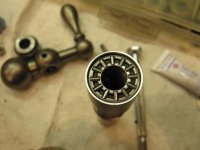My SB16 does the same thing. I would put a brass washer in between the nut and shaft
Could the screw have worn down the face of that nut?
That's where the wear happens - between the underside (small, inner diameter) of the bushing, and the top (or outside) of the collar formed on the leadscrew.
Typically there's not that much wear on the top (outer, larger) portion of the bushing which mates with the underside of the graduated dial - although there will be some there, as well.
My approach is to remove the wear rings between the bushing and the dial, by facing them, so they are dead flat. Then if there's a lot of grooving between the collar and the inside of the bushing,
face those as well. This of course *increases* the lash in the assembly. The next step is to see if there's too much lash to make it up by shorting the stub on the end of the lead screw. Shorting that means possibly running out of threads for the funny slotted nut to hold the entire thing together.
If need be the next two approaches are, in order, make a up a steel washer to put between the leadscrew collar and the inside of the bushing, or if need be, cut the old threaded end of the leadscrew off and sliver solder in a blank, and re-thread for 12-24, allowing the seating location for the handle, to be moved inward as much as needed to make the lash near zero.
Bottom line is, wear makes the lash increase everywhere in the assembly overall. You either need to add new material in (washer) or shorten the distance between the critical surfaces (between the leadscrew collar and the end of leadscrew where the handle seats) to make it all work the way it was intended.






 I need to adjust the shims under the headstock bearing caps. It appears the front bearing has about .002" much play in it. I understand that the excessive play will contribute to chatter. The shims are laminated, so I should be able to peel off a layer or two and have that dialed in.
I need to adjust the shims under the headstock bearing caps. It appears the front bearing has about .002" much play in it. I understand that the excessive play will contribute to chatter. The shims are laminated, so I should be able to peel off a layer or two and have that dialed in.